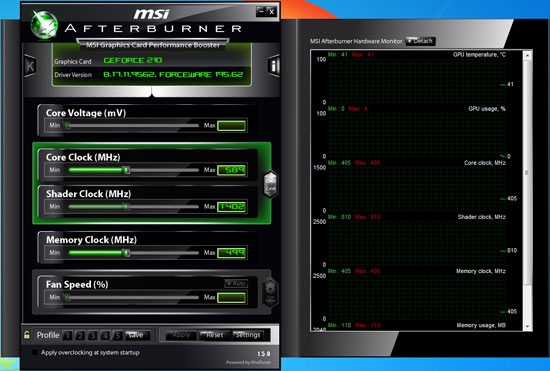
Original Link: https://www.anandtech.com/show/2939
Since NVIDIA did not send out review samples for the G(T) 200 series last year, we’ve been slowly building up our database of results as cards have arrived from the vendors themselves. We saw the GT 220 late last year, and last month we finally saw the GT 240. Thanks to MSI, today we’ll be looking at the final card in the (G)T 200 series: the GeForce 210. The specific card we’re looking at is MSI’s N210-MD512H.
| 9600GT | GT 220 | 9500GT |
9400GT
|
G 210 | |
| Stream Processors | 64 | 48 | 32 | 16 | 16 |
| Texture Address / Filtering | 32 / 32 | 16 / 16 | 16 / 16 | 8 / 8 | 8 / 8 |
| ROPs | 16 | 8 | 8 | 4 | 4 |
| Core Clock | 650MHz | 625MHz | 550MHz | 550MHz | 589MHz |
| Shader Clock | 1625MHz | 1360MHz | 1400MHz | 1400MHz | 1402MHz |
| Memory Clock | 900MHz (1800MHz effective) GDDR3 | 900MHz (1800MHz effective) GDDR3 | 400MHz (800MHz effective) DDR2 | 400MHz (800MHz effective) DDR2 | 500MHz (1000Mhz effective) DDR2 |
| Memory Bus Width | 256-bit | 128-bit | 128-bit | 128-bit | 64-bit |
| Frame Buffer | 512MB | 512MB | 512MB | 512MB | 512MB |
| Transistor Count | 505M | 486M | 314M | 314M | 260M |
| Manufacturing Process | TSMC 55nm | TSMC 40nm | TSMC 55nm | TSMC 55nm | TSMC 40nm |
| Price Point | $69-$85 | $69-$79 | $45-$60 | $40-60 | $30-$50 |
Like the GT 220, the G210 started life over the summer as an OEM-only card, earning its wings for a public launch in October along-side the GT 220. G210 is based on GT218, the smallest member of NVIDIA’s DirectX 10.1 GPU lineup, built out of 260M transistors and measuring a mere 57mm2 on TSMC’s 40nm process. As a product it replaces NVIDIA’s similar 9400GT, while in terms of pricing it replaces the slower 8400 GS.

Coupled with the GT218 GPU on the G210 is 512MB of DDR2 RAM, using the customary 64bit memory bus. Interestingly, unlike most other entry-level products, the G210 only comes in 1 memory configuration: 512MB. Even more interesting are the DDR2 chips on our MSI card – 4 chips we can’t identify bearing the ATI logo.
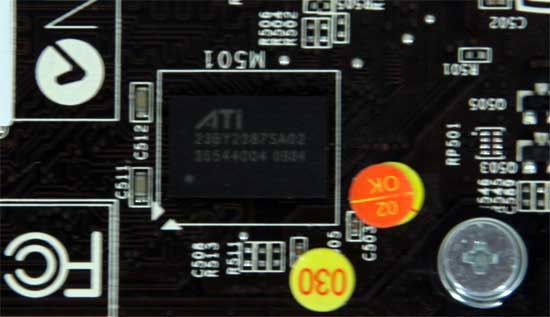
Since the G210 is intended to replace the 9400GT, the GPU configuration is basically the same, composed of 16 SPs, 8 TMUs, and 4 ROPs. The clocks are 589MHz for the core, 1402MHz for the shaders, and 500MHz (1000MHz effective) for the RAM. Compared to the GT 220, this gives the G210 around 30% of the shader power, 50% the texture and ROP power, and 27% of the memory bandwidth. All of this consumes 30W under load, and less than 7W when idling.
The G210 is a low-profile card, the only reference card to be that way out of NVIDIA’s entire 200-series lineup. NVIDIA’s reference design (not that anyone quite uses it) is a single-slot card with a similarly wide active cooler. For our MSI card, MSI has forgone that for a passive design, using a single double-wide heatsink. Most G210 cards do use some form of an active cooler, so MSI’s N210 is fairly unique in that regard.
Since the G210 is a low-profile card, the port configurations are as expected: 1 DVI, 1 HDMI or DisplayPort, and then the detachable VGA port. In the case of MSI's card, they have gone with an HDMI port as the second digital port, while the VGA port can be used on a full-profile bracket or a second bracket in a low-profile case.
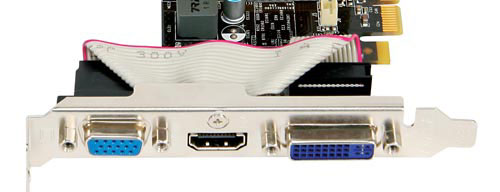
Finally, in terms of pricing, the G210 is the ultimate budget card. With the MSI card going for only $30 after rebate, it’s for all practical purposes as cheap as a video card can get. Even the DDR2 version of the Radeon HD 5450 we reviewed last week goes for nearly 50% more. In terms of pricing this makes its competitors the GeForce 8400GS and the DDR2-based Radeon HD 4350, the latter of which is also its closest competitor to in terms of feature parity. It goes without saying that this is the ultimate entry-level card, and performs accordingly.
One thing that specifically sets MSI’s G210 card apart from the others is that it comes packed with more than the bare minimum as is usually found with cards at this price level. In terms of included hardware you don’t get anything besides the card, the manual, the brackets, and the software – but it’s the software that makes the difference here.
MSI offers several software utilities for all of their cards, and the cornerstone of this is their Afterburner software. In a nutshell Afterburner is the distilled child of the long-favored RivaTuner utility, using RivaTuner’s technology to offer a straightforward video card overclocking and monitoring tool. We’ll be looking at Afterburner and other overclocking utilities in-depth later this month, but we wanted to take a quick look at it today.
As a RivaTuner descendant, Afterburner offers overclocking of the core, shader, and memory clocks, along with the usual suite of clock and temperature monitoring. Furthermore despite being an MSI utility, it works on a generic level with all NVIDIA and AMD GPUs that Afterburner supports. As a trump card specifically for MSI’s cards, it’s also capable of doing voltage tweaking on most of their cards. In the case of the G210 however, this feature is not supported (which would be a bad idea anyhow since it’s passively cooled).
Finally, we took a look at the G210’s usability in an HTPC setting. With the same VP4 decoder and 8-channel LPCM audio capabilities as on the rest of NVIDIA’s 40nm G(T) 200 series, the G210 has the potential to be a solid HTPC card on paper. As with the other low-profile cards we’ve been looking at this month, we ran it through the Cheese Slices HD deinterlacing test, which as we’ve seen can quickly expose any flaws or limitations in a card’s video decoding and post-processing capabilities
Unfortunately the G210 did extremely poorly here. In our testing the G210 would consistently drop frames when trying to run the Cheese Slices test, leading to it only processing around 2 out of every 3 frames. NVIDIA doesn’t offer any deinterlacing settings beyond enabling/disabling Inverse Telecine support, so the interlacing method used here is whatever the card/drivers support, which looks to be an attempt at Vector Adaptive deinterlacing.
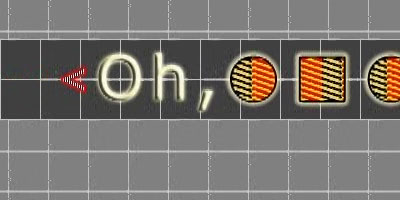
GeForce 210
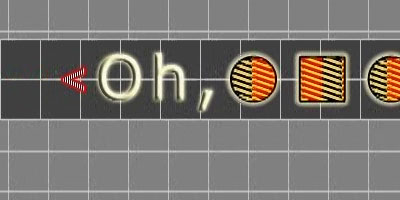
GeForce GT 220
The quality is reminiscent of VA deinterlacing, however it’s not as clean as what we’ve seen on the GT 220. More to the point, the G210 clearly doesn’t have the processing power to do this, but it’s unable to fall back to a lesser mode. Cheese Slices isn’t a fair test by any means, but it does mean something when a card can’t gracefully fail the test. Once we throw deinterlacing out of the equation however the G210 has no problem playing back progressively encoded MPEG-2 and H.264 material. It looks to only be serious limited when deinterlacing, which means the G210 is only at a serious disadvantage with interlaced material such as live television.
It should come as little surprise that since the G210 is the cheapest card we have tested, it’s also the slowest. Rather than rattle off individual benchmarks, we’re just going to show one or two charts for each game in our test suite, including a chart comparing it to next-tier cards such as the GT 220.
| CPU: | Intel Core i7-920 @ 3.33GHz |
| Motherboard: | Intel DX58SO (Intel X58) |
| Chipset Drivers: | Intel 9.1.1.1015 (Intel) |
| Hard Disk: | Intel X25-M SSD (80GB) |
| Memory: | Patriot Viper DDR3-1333 3 x 2GB (7-7-7-20) |
| Video Cards: |
AMD Radeon HD 5970 AMD Radeon HD 5870 AMD Radeon HD 5850 AMD Radeon HD 5770 AMD Radeon HD 5750 AMD Radeon HD 5670 512MB AMD Radeon HD 5450 512MB AMD Radeon HD 4890 AMD Radeon HD 4870 1GB AMD Radeon HD 4850 AMD Radeon HD 3870 AMD Radeon HD 4770 AMD Radeon HD 4670 512MB AMD Radeon HD 4550 512MB NVIDIA GeForce GTX 295 NVIDIA GeForce GTX 285 NVIDIA GeForce GTX 275 NVIDIA GeForce GTX 260 Core 216 NVIDIA GeForce GTS 250 NVIDIA GeForce 8800 GT NVIDIA GeForce 9600 GT NVIDIA GeForce GT 240 NVIDIA GeForce GT 220 NVIDIA GeForce 210 |
| Video Drivers: |
NVIDIA ForceWare 190.62 NVIDIA ForceWare 195.62 AMD Catalyst Beta 8.66 AMD Catalyst Beta 8.66.6 AMD Catalyst 9.9 AMD Catalyst Beta 8.69 |
| OS: | Windows 7 Ultimate 64-bit |
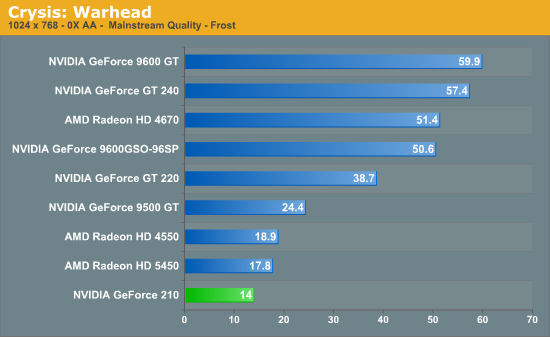
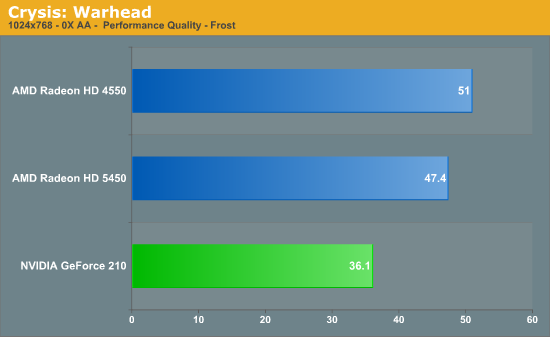
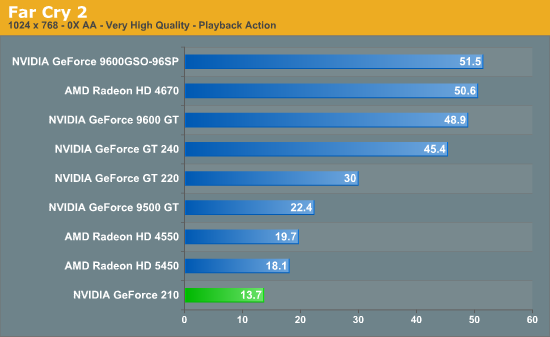
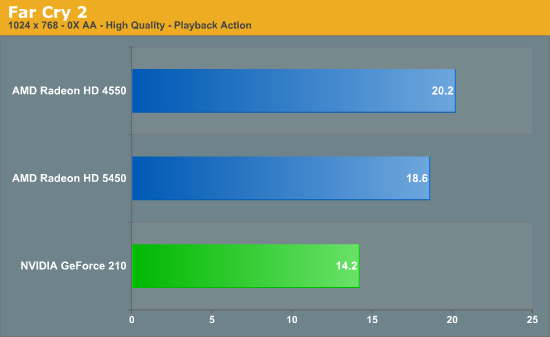
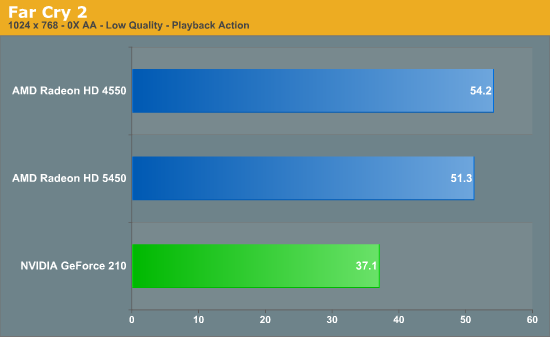
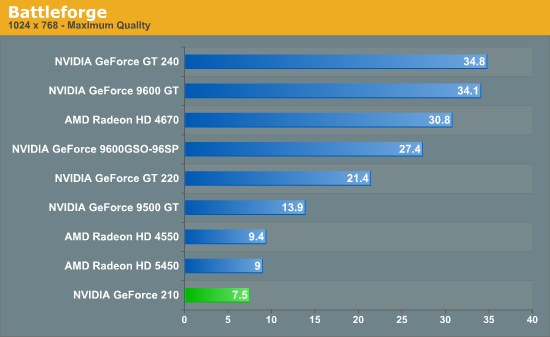
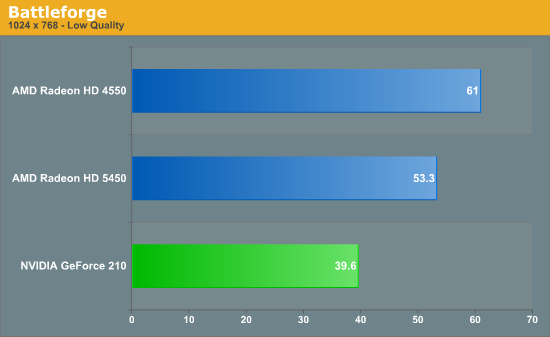
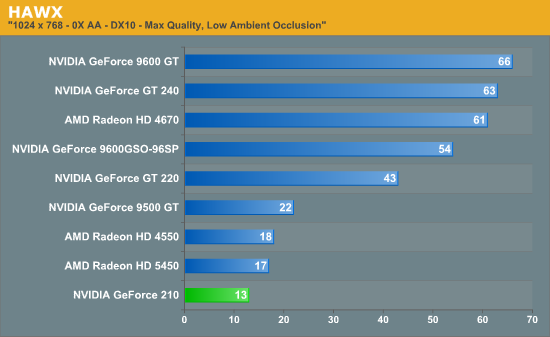
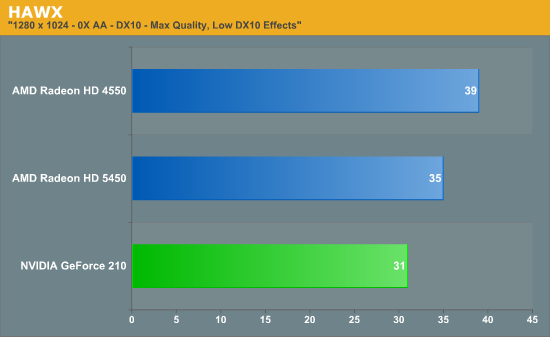
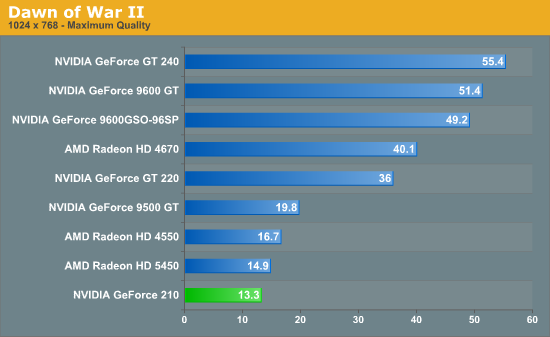
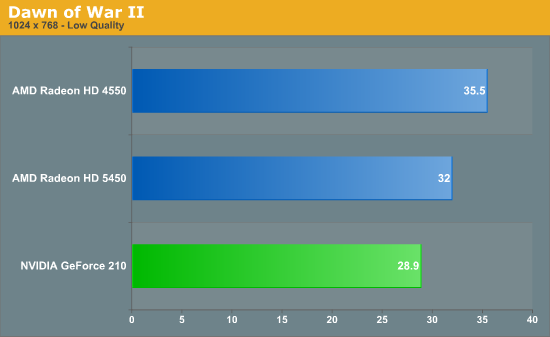
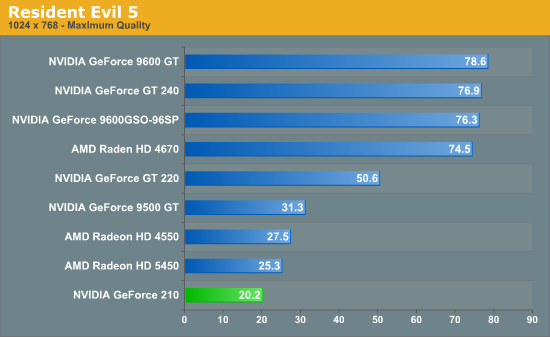
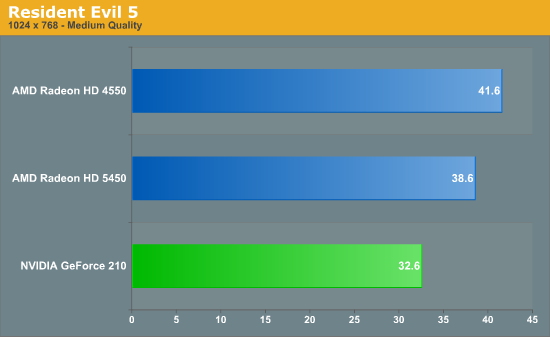
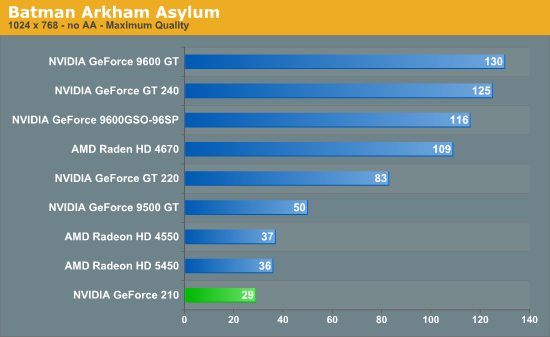
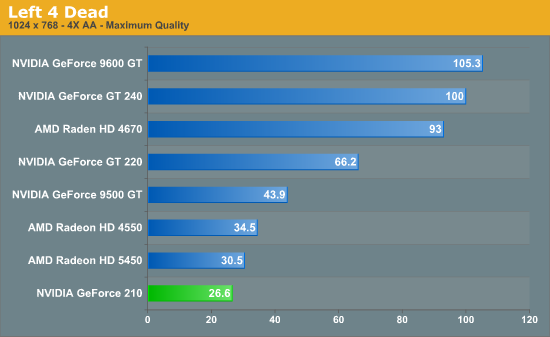
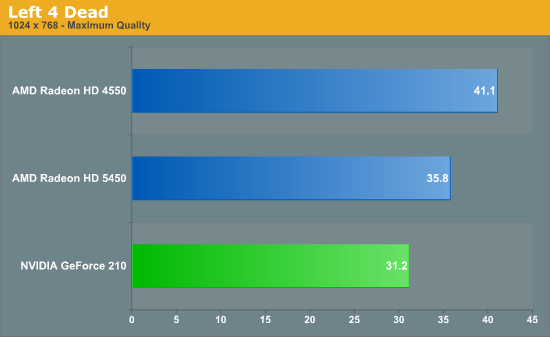
Generally speaking, the G210 is playable at 1024x768 at low settings, but little more than that. The exceptions to this are our less-complex games: Resident Evil 5, Batman, and Left 4 Dead. Resident Evil can sustain 30fps at medium quality graphics, while Batmand and L4D can sustain that framerate using high quality graphics.
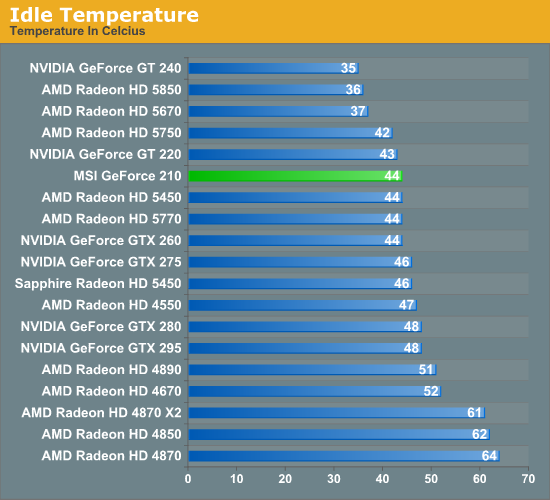
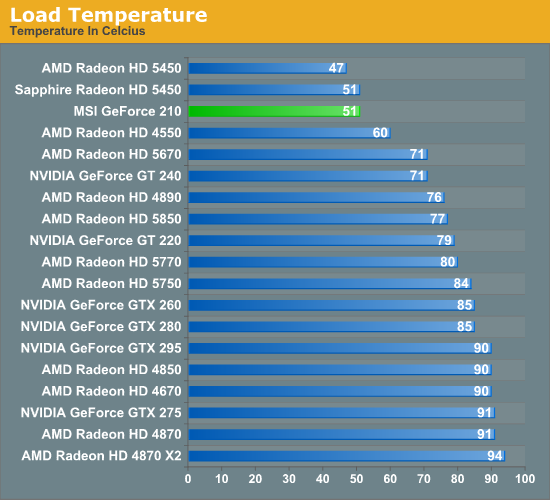
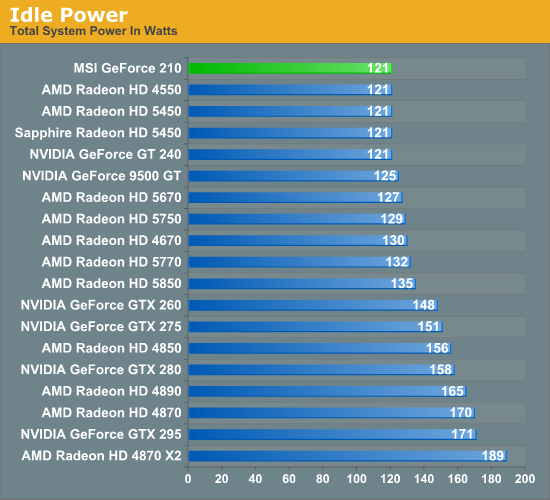
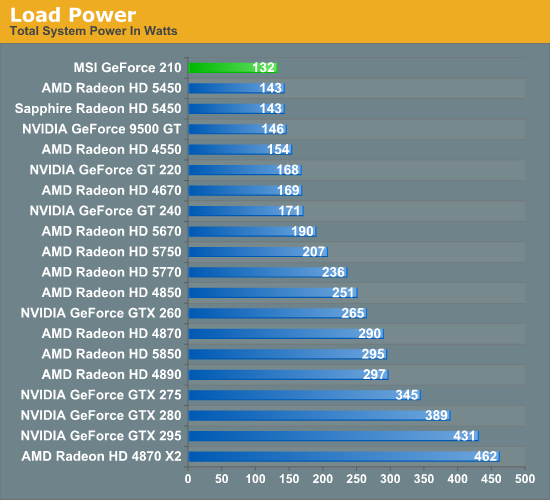
On paper the G210 should be slightly more power hungry and slightly warmer than the Radeon HD 5450 we tested last week. In practice it does better than that here, although we’ll note that some of this likely comes down to throttling NVIDIA’s drivers do when they see FurMark and OCCT. At any rate the G210 is the lowest consuming card out of all the cards we have tested, while its load temperatures are second only to the 5450. Idle power usage and temperatures are at 121W and 51C respectively, which is in-line with other passively cooled cards of this nature.
MSI’s N210-MD512H is priced as the ultimate budget card, and it performs accordingly. It’s slower than next-tier cards by a significant amount, but it’s still fast enough that it can at least run every game in our test suite at some level, which is going to be better than what most IGP-based systems can do right now. It goes without saying that you can buy much faster cards even among the limited selection of the low-profile market, but any such card is going to cost a great deal more than $30. So much like the Radeon HD 5450 we took a look at last week, this is a card best suited for buyers moving up from an IGP while needing to do so on a very limited budget.
Looking at our data, we’re a bit surprised that NVIDIA didn’t make the reference G210 design a passively cooled card. Based on MSI’s use of a double-wide heatsink, G210 is plenty suitable for passive operation and likely even a single-wide operation with some care. For a card like the G210, we can’t think of any good reason to use a cooler with a fan if there’s enough room in a computer to use a card with a heatsink. To that end MSI’s G210 looks to be one of the best G210 cards available since it’s one of the only ones with a passive cooler.
We do have a single disappointment though, and that’s for HTPC use. We’re less concerned about the audio limitations (let’s be fair, this card launched back in the summer of 2009) as we are the results of our video test. We weren’t expecting to get great quality out of an entry-level card but we were expecting it to at least fall back gracefully on deinterlacing. The fact that it’s the only card that can’t at least do something smoothly on the Cheese Slices test is disheartening.
Finally, it’ll be interesting to see what NVIDIA does to replace the G210 late this year. It’s reasonable to assume that GF100 will cascade down in to a part similar to G210, which will be a definite benefit for NVIDIA since it means they can bring complete audio bitstreaming to a card at this price point. What we’re left wondering is how they’re going to do this: do they do a 40nm GF100 derivative, or do they push the envelope some and do a 28nm part.
Since G210 is already based on 40nm, a GF100 derivative is ultimately going to be bigger than the GT218 GPU which makes it harder to offer a card at $30. A 28nm GPU would presumably let them pack in GF100/DX11 functionality without expanding the die, but a 28nm product this year is ultimately going to be dependent on how well Global Foundries’ 28nm process is coming along.
Of course we’ll first have to see how GF100 does when it finally launches next month…

